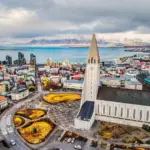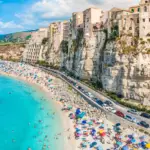
Welcome to Havana, Cuba, a vibrant and lively city. Here, music is an essential part of the culture, the streets transform into dance floors dance and the old cars tell fascinating stories about the history of the country. Visiting Havana is like going back in time and experiencing a rich culture and diverse.
Main points of this section:
- Discover the vibrant city of Havana, Cuba;
- Learn about Havana's rich culture, including music, dance, old cars and architecture;
- Explore the history of Havana, from its founding to the present day.
The History of Havana Cuba
Havana, Cuba, founded by Spanish conquistadors in 1519, is a city rich in history and culture. During the colonial era, the city was a important port where treasures and slaves were brought from Spanish colonies to Europe. In the following decades, Havana was the scene of many struggles for independence, including the 19th-century Cuban War of Independence.
In the 20th century, the city experienced drastic political changes with the Cuban Revolution led by Fidel Castro in 1959. Since then, Havana has been a city in constant evolution, with many changes in the economy, culture and society.
Despite all these changes, the city maintains its historical beauty and architectural. Havana is famous for its bustling streets, colorful colonial buildings, and historic squares. Havana's historic center is a UNESCO World Heritage Site.
Furthermore, Havana is a tourist destination known worldwide for its culture rich and vibrant. The city is famous for its music, dance, old cars and unique gastronomy. The history from Havana Cuba is therefore a central part of the city's identity, and an essential part of unforgettable experiences that visitors can have in the city.
The Music of Havana Cuba
If there's one thing that defines Havana, it's its music. From dawn to dusk, the streets of Havana echo with Cuban music. With its infectious beats and catchy rhythms, music is an essential part of everyday life in Havana.
THE music from Havana Cuba is rich and diverse, reflecting its history of cultural influences. The most popular genres include salsa, rumba, son cubano, and timba. Son cubano is a style of music that originated in Cuba in the early 20th century, characterized by its syncopated rhythm and smooth melody. Rumba is a style of music and dance that originated among Black communities in Cuba in the late 19th century. Salsa, in turn, is a fusion of Cuban, Puerto Rican, and American rhythms, popularized in the 1970s.
Cuban music is so important to Havana's culture that it's practically impossible to walk the city streets without hearing live music. There are many venues offering live music, from small bars to large nightclubs. Most live performances are free, and you can feel the energy and passion of the musicians as they play.
The Best Places to Hear Live Music in Havana, Cuba
If you're looking for an authentic Cuban music experience, check out some of the best places to hear live music in Havana:
| Location | Gender |
|---|---|
| La Zorra y el Cuervo | Jazz |
| House of Music | Parsley |
| Cuban Art Factory | Mixing of genres |
| El Gato Tuerto | Bolero and jazz |
These venues offer not only live music but also a authentic experience of culture of Havana. Music is an essential part of life in Havana, and you can't help but get involved in it.

Dancing through the Streets of Havana
In Havana, dance is a highly valued form of expression. It's not uncommon to see Cubans dancing in the city streets, to the music that plays on every corner. Cuban music is a fundamental element of Havana's culture, and dance is its soul. Cubans love to dance and feel that it is a way to connect with their cultural heritage.
People dance everywhere in Havana, whether in clubs, bars, squares, or anywhere there's room to move. Most Cubans learn to dance from a young age, whether at home or at school. They have an incredible sense of rhythm and movement that is fascinating to watch.
strolling through the streets of Havana
One of the best ways to experience dance in Havana is to stroll the streets. The city's plazas are a popular place to dance, with bands playing live music and people dancing in pairs or groups. Plaza Vieja, located in the heart of Havana's historic center, is a great place to see dance in action.
Another popular place to dance in Havana is the Malecón, a seaside promenade where people gather to watch the sunset and dance to Cuban music. The Malecón is a very lively place, especially on weekends.
Dance is so important to Cubans that Havana hosts numerous dance festivals throughout the year. The Afro-Cuban Music and Dance Festival is a popular event that celebrates the African heritage of Cuban music and dance. There's also the Havana International Dance Festival, which features contemporary and classical dance performances from around the world.

Old Cars of Havana
Vintage cars are one of Havana's most iconic images. They're found everywhere, and each one tells a unique story about Cuba's history. Many of the vintage cars you'll see on the streets of Havana date back to the 1950s, when relations between Cuba and the United States fell apart and imports of American cars were stopped.
But instead of abandoning their cars, Cubans kept them running with improvised spare parts and a lot of ingenuity. Today, these vintage cars are an important part of the Havana landscape and a testament to the resilience and perseverance of the Cuban people.
If you want to experience the thrill of riding in one of these vintage cars, there are several options available in the city. You can opt for a sightseeing tour in a classic convertible or simply take a taxi to your next destination in an old Buick or Chevy.
If you're particularly interested in vintage cars, don't miss the opportunity to visit the Automobile Museum, located in Havana's Vedado neighborhood. There, you'll find an impressive collection of vintage cars, including some of the rarest and most valuable models.
You old cars of Havana They're an important part of the city's identity and a unique opportunity to experience a bit of Cuban history and culture. Be sure to include them in your itinerary when visiting Havana.

The Architecture of Havana
THE Havana architecture is a fascinating blend of styles, influenced by centuries of history and diverse cultures. From Spanish colonial buildings to Art Deco constructions, Havana architecture It's a real history lesson.
One of the most striking features of the Havana architecture are the colonial buildings, dating back to the 16th century. Some of the most notable examples include the Havana Cathedral, the Castillo de los Tres Reyes del Morro, and the Fortress of San Carlos de la Cabaña.
Another prominent style is Art Deco, which became popular during the 1920s and 1930s. Havana has many notable examples of this style, including the Edificio Bacardi and the Edificio Lopez Serrano.
A more recent style that has become increasingly popular in Havana is modern architecture. Notable examples include the Hotel Nacional de Cuba and the Edificio Focsa.
In Havana, there are also many historic buildings that have been converted into restaurants, bars, and hotels, allowing visitors to experience the beauty of Havana's architecture while enjoying local hospitality.
Cuban Cuisine in Havana
Havana's cuisine reflects the fusion of different cultures that have influenced the island over the years. Typical Cuban dishes are tasty and varied, with pork, beans, and rice standing out.
One of the best ways to experience local cuisine is to visit Havana's traditional restaurants and bars. La Bodeguita del Medio is one of the city's most famous spots, where you can enjoy a delicious Cuban sandwich and a mojito, Cuba's national drink.
Another popular spot is El Floridita, once frequented by the famous American writer Ernest Hemingway. The house specialty is the Daiquiri, which you can enjoy while admiring the quaint decor.
If you want to experience Cuban cuisine with a modern twist, try the San Cristobal Paladar restaurant, which was visited by US President Barack Obama during his 2016 visit to Cuba. There, you can try delicious dishes like rabbit with mushrooms and lamb with eggplant.
Don't forget to try Cuban coffee, which is known for its strong and flavorful flavor. There are many cafés in Havana where you can enjoy a cup of coffee while observing the bustling city life.

Havana Nightlife
Havana is a city where nightlife is an essential element for having fun and getting to know the city. local cultureThe city offers a variety of options for all tastes and styles, from dance clubs to bars and restaurants. Cuban music is the perfect soundtrack to accompany all these experiences.
Here are some suggestions for you to enjoy the Havana nightlife:
| Location | Type | Description |
|---|---|---|
| The Cuban Art Factory | Cultural Center | A place where art, music, dance, and gastronomy meet. It's a creative and innovative space where you can find local and national artists. |
| House of Music | Live music club | One of the most popular dance venues in Havana. Live music features local artists performing salsa, rumba, son, and other Cuban musical genres. |
| El Floridita | Bar | Famous for its daiquiri cocktail, this historic bar has been frequented by international artists and celebrities for decades. The Art Deco decor and live music create a unique atmosphere. |
To learn even more about Havana nightlife, you can explore the streets of the Vedado neighborhood, where there are many bars and restaurants, or visit Callejón de Hamel, which is famous for its street art and Afro-Cuban music.
THE Havana nightlife is a crucial element in understanding Cuban culture and the Cubans' passion for music and dance. Don't miss the opportunity to experience all that Havana has to offer at night!
Exploring the Surroundings of Havana
If you have time during your stay in Havana, it's worth exploring the city's surroundings. There are many popular day trips that allow you to experience other parts of Cuba.
Varadero
Varadero is a beautiful beach located about 140 km from Havana. With its 20 km of white sand and crystal-clear water, it's one of Cuba's most popular beach destinations. You can take day trips from Havana or stay a few days at one of Varadero's many beachfront resorts.
| What to do in Varadero: | Enjoy the beach and the seaVisit Josone ParkExplore Saturn CaveTake a catamaran ride |
|---|
Viñales
Located about 180 km west of Havana, Viñales is a unique rural landscape marked by impressive rock formations and tobacco plantations. You can take a day trip from Havana or stay a few days in one of the local inns to experience rural Cuban life.
| What to do in Viñales: | Visit tobacco plantations, explore local caves, ride horses along local trails, take a bike ride |
|---|
Eastern Beaches
The beaches of eastern Havana are located about 20 km from the city. They are quieter and less crowded than those in Varadero, ideal for those seeking a more relaxing atmosphere.
| What to do on the eastern beaches: | Enjoy the beach and the seaTry fresh seafood at one of the local restaurantsVisit Boca Ciega Natural ParkTake a boat trip |
|---|
These are just some of the many tours that can be done in outskirts of Havana. Ask your hotel or travel agency about other options for exploring this beautiful region.
Tips for Traveling to Havana, Cuba
Planning a trip to Havana, Cuba, can seem like a daunting task, but with a few helpful tips, you can enjoy a pleasant stay in this vibrant, culturally rich city.
- Visa: Brazilians require a visa to enter Cuba. You can apply directly at the Cuban Consulate or through a travel agency.
- Best time to visit: Cuba has a tropical climate, with high temperatures and high humidity year-round. However, the best time to visit Havana is between November and April, when temperatures are more pleasant.
- Coin: Cuba's official currency is the Cuban peso, but the US dollar is widely accepted in the city. It's recommended to carry cash, as international credit cards are not widely accepted.
- Transport: Havana is an easy city to get around on foot, but if you need transportation, taxis are available throughout the city, as well as buses and bicycles for rent. Be sure to negotiate the price before getting into a taxi.
- Security: Havana is a relatively safe city, but as in any large city, you need to exercise caution and be aware of your belongings. Avoid carrying valuables and always check the security of the areas you're visiting.
By following these simple tips, you can have a safe and enjoyable experience in Havana, Cuba. Don't miss the opportunity to explore the city's rich culture, sample its delicious food, and enjoy its vibrant nightlife.

Conclusion
In this final section, we recap Havana's rich culture and highlight aspects that make this city so special. Music is an essential part of daily life in Havana, and rhythms like salsa, son cubano, and rumba fill the air. Dance is a highly valued form of expression for Cubans, and it's common to see people dancing to Cuban music on the city streets.
Vintage cars are an iconic feature of Havana, telling fascinating stories about the country's history. Havana's architecture reflects its history and cultural influences, from colonial buildings to more modern examples, contributing to the city's beauty. Cuban cuisine is a fusion of flavors and influences from different cultures, with delicious typical pork-based dishes.
Havana comes alive when the sun sets. The city's nightlife offers live music, dancing, and a vibrant atmosphere. Beyond Havana, there are beautiful places to explore in the surrounding area, such as the beaches of Varadero or the rural landscape of Viñales.
We hope this article inspires you to visit Havana and experience all this vibrant city has to offer. Don't miss the opportunity to enjoy Havana's rich culture, dance in the streets, admire the vintage cars, and sample the delicious Cuban cuisine. See you soon in Havana!
FAQ
Q: Where is Havana Cuba?
A: Havana is the capital of Cuba, located on the north coast of the island.
Q: How important is music in Havana?
A: Music is an essential part of life in Havana, reflecting the rich culture and joy of the Cuban people.
Q: Where can I dance in the streets of Havana?
A: On the streets of Havana, especially in places like Callejón de Hamel, it is common to see people dancing to Cuban music.
Q: Why are vintage cars so popular in Havana?
A: Vintage cars became an iconic part of the Havana landscape due to vehicle import restrictions following the 1959 Cuban revolution.
Q: What are the architectural styles in Havana?
A: Havana has a mix of architectural styles, including Spanish, colonial and neoclassical influences.
Q: What are the typical dishes of Cuban cuisine in Havana?
A: Some typical dishes of Cuban cuisine in Havana include the famous Cuban sandwich, roast pork and moros y cristianos (rice and beans).
Q: Where can I enjoy Havana's nightlife?
A: There are several popular spots to enjoy Havana's nightlife, such as Casa de la Música and Tropicana Cabaret.
Q: What are popular tours around Havana?
A: Some popular tours in the outskirts of Havana include visiting the beaches of Varadero and exploring the countryside of Viñales.
Q: What are your travel tips for Havana, Cuba?
A: Some travel tips for Havana Cuba include obtaining a proper visa, familiarizing yourself with the local transportation system, and exchanging your currency to CUC.
Lucas Wanderlust has a tireless spirit of adventure, always seeking new travel experiences. Fascinated by the world and the possibility of exploring unknown destinations, he fell in love with the sense of freedom and self-discovery that traveling alone provides. With a backpack on his back and a heart open to the unknown, Lucas embarks on exciting journeys, where each destination becomes a unique chapter in his life story. He gives himself body and soul to the magic of solo travel, inspiring others to follow in his footsteps and discover themselves through adventure.







